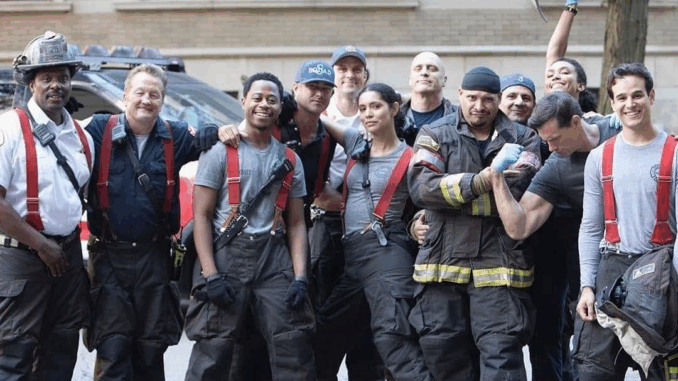
For over a decade, Chicago Fire has thrilled viewers with edge-of-your-seat rescues, high-stakes emergencies, and plenty of firehouse drama. But beneath the heat, smoke, and blazing infernos lies a masterclass in special effects wizardry — and one man behind it all: John Milinac, the show’s special effects coordinator and self-proclaimed fire whisperer.
Since the series debuted in 2012, Milinac has turned up the heat — literally — transforming scripts into visually stunning, and often terrifyingly real, scenes of fire-fueled chaos. While the cast may bring the characters to life, it’s Milinac who brings the flames.
A Controlled Chaos
When Milinac talks fire, he’s not just speaking in metaphors. On any given episode, he and his 13-person crew juggle everything from smoke-choked interiors to crumbling rooftops and exploding vehicles. “Every burn we do is a custom build,” he tells Variety. “Whether it’s a fully engulfed living room or a car fire in an alley, everything starts with safety, precision, and storytelling.”
It’s not just about setting things on fire — it’s about knowing how and why to do it. “You learn what fire can do,” Milinac says. “You apply what you’ve learned and then show what the audience should expect to happen — all while keeping everyone safe.”
The Fire Starts in the Writers’ Room
Before any flames spark on set, the fire begins with the show’s writers. Often inspired by real-life incidents, the scripts bring jaw-dropping realism to each episode’s emergency. Milinac is then called in to translate those scenarios into visual effects — and determine what’s technically possible.
From there, he coordinates with every department — writers, directors, production designers, costume teams, and actors — to make the scene come to life. “Every location is different. Every fire behaves differently,” Milinac explains. “We treat each one like a new puzzle.”
How the Fire Gets Made
Forget CGI smoke or fake embers — most of Chicago Fire’s infernos are the real deal. Using propane as the primary fuel, Milinac’s team constructs steel-lined, fire-resistant sets equipped with hidden gas lines and flame control valves — each one managed live by off-camera operators.
Think of it as an orchestra of fire, where every flame is assigned a number and a level, and each “instrument” must be played in harmony. “We’re like conductors,” Milinac says. “We direct where the fire goes, how high it burns, and how long it lasts.”
Some props, like fake electronics or drywall, are carefully crafted to look combustible while remaining safe. Others, like steel furniture or controlled igniters, keep the blaze where it belongs. And when things don’t quite burn on cue? A little brushed-on fuel and some digital magic in post-production can fix that.
Real Smoke, Real Heat, Real Danger
Filming on location adds a whole new layer of complexity. “You might be shooting at a building with three windows one week and ten the next,” Milinac says. “You’ve got to consider city views, adjacent properties, and the logistics of keeping everything safe and contained.”
The sets are carefully ventilated to keep heat from building up and to allow visibility. “In a real fire, you wouldn’t see your hand in front of your face. But on TV, we need to see our actors. We create that illusion — thick enough to be believable, thin enough for drama.”
The Actors Feel the Heat Too
While Milinac engineers the flames, it’s the actors who must walk through them. Whether it’s Taylor Kinney’s Severide or a first-time day player playing a trapped victim, Milinac ensures that every performer is comfortable with the fire they’re working near.
“Nothing is done without the actors’ input. If we’re doing a mortar fireball, we show them the pressure and impact first,” he explains. “They don’t need to be worried about their safety — they just need to focus on the performance.”
The costumes are authentic, and so is the smoke. Every flame is calibrated not only for effect but also for human endurance. “We’re constantly thinking about heat escape, breathable air, and how long someone can realistically stay in the set,” Milinac says.
Why Story Always Comes First
Despite the explosive visuals, Milinac insists that Chicago Fire isn’t really about fire at all. “The fire is a tool — a character — but it’s not the story,” he says. “The story is always about the people. Their emotions. Their stakes. Fire raises the tension, but it’s never there just for show.”
It’s that balance — between spectacle and storytelling — that keeps fans coming back week after week, season after season. And with every crackle of flame or smoldering rescue, Milinac and his team are there behind the scenes, turning up the heat — but always in service of the story.
“We’re not just setting fires,” Milinac adds. “We’re building emotion. And we’re doing it one controlled flame at a time.”
Behind the Blaze Quick Facts:
🔥 Primary Fuel: Propane
🔥 Set Material: Fireproof steel & drywall
🔥 Team Size: 13-person SFX unit
🔥 Safety First: All flames mechanically controlled
🔥 Post-Production Assist: Digital flame enhancements, when needed
So the next time Firehouse 51 rushes into a towering inferno, remember: every flicker, flare, and fireball is part of a carefully orchestrated dance — where real heat meets reel drama.
